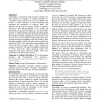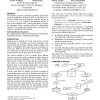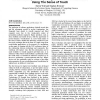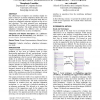CHI
2005
ACM
14 years 12 months ago
2005
ACM
Guessability is essential for symbolic input, in which users enter gestures or keywords to indicate characters or commands, or rely on labels or icons to access features. We prese...
CHI
2005
ACM
14 years 12 months ago
2005
ACM
In the contemporary information-saturated world, there is a need for an easier, faster, and more social way to keep office workers updated and better aware of surrounding activiti...
CHI
2005
ACM
14 years 12 months ago
2005
ACM
We introduce a browser evaluation test (BET), and describe a trial run application of the test. BET is a method for assessing meeting browser performance using the number of obser...
CHI
2005
ACM
14 years 12 months ago
2005
ACM
Listening to music on personal, digital devices while mobile is an enjoyable, everyday activity. We explore a scheme for exploiting this practice to immerse listeners in navigatio...
CHI
2005
ACM
14 years 12 months ago
2005
ACM
CHI
2005
ACM
14 years 12 months ago
2005
ACM
This paper discusses the use of eye contact sensing for focus selection operations in remote controlled media appliances. Focus selection with remote controls tends to be cumberso...
CHI
2005
ACM
14 years 12 months ago
2005
ACM
This paper discusses the design of a physical and digital system intended to allow for easy manipulation and interaction with the tremendous amount of options present in advanced ...
CHI
2005
ACM
14 years 12 months ago
2005
ACM
The effectiveness of adaptive user interfaces highly depends on the how accurately adaptation satisfies the needs of users. This paper presents an empirical study that examined tw...
CHI
2005
ACM
14 years 12 months ago
2005
ACM
This paper presents a novel and intuitive paradigm for interacting with autonomous animated characters. This paradigm utilizes a mobile device to allow people to transport charact...
CHI
2005
ACM
14 years 12 months ago
2005
ACM
This paper describes a multi-user version of the "Virtual Raft Project" being exhibited in the Interactivity Program at CHI 2005. The Virtual Raft Project is an interact...




